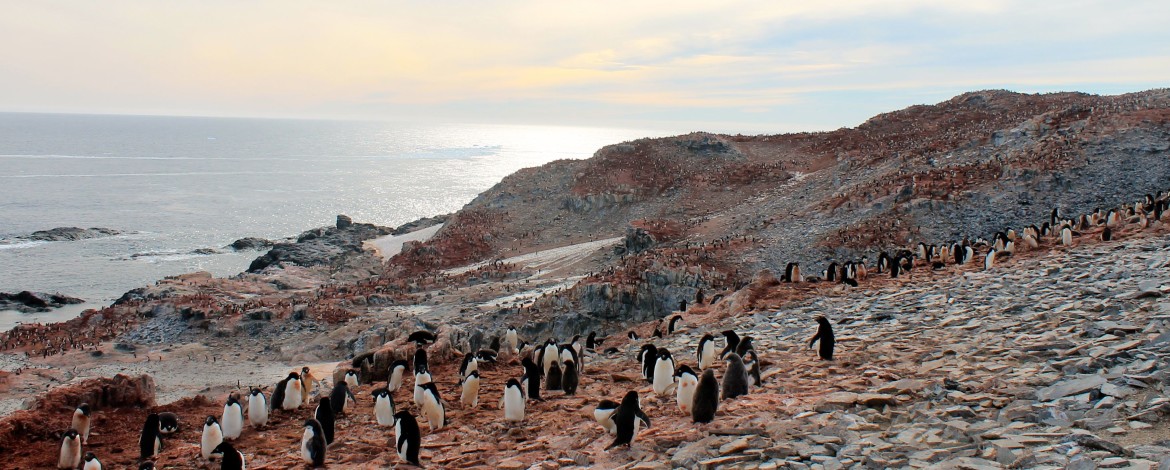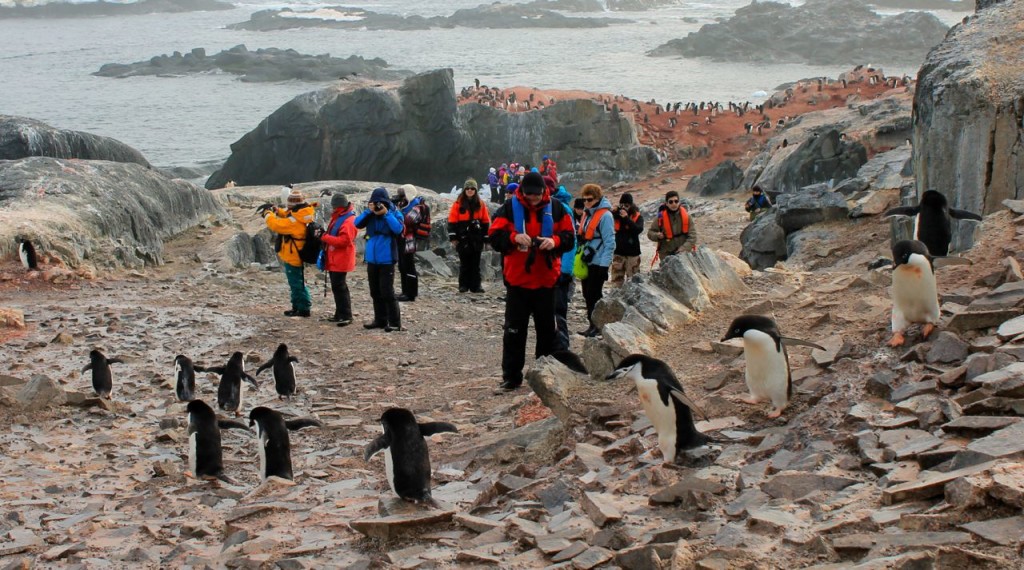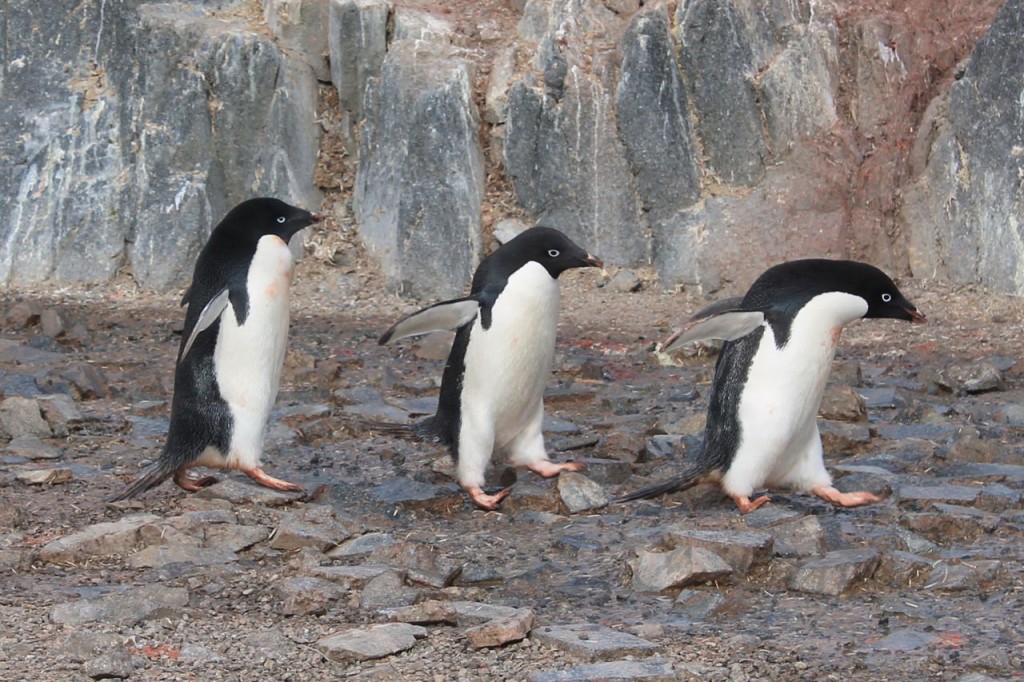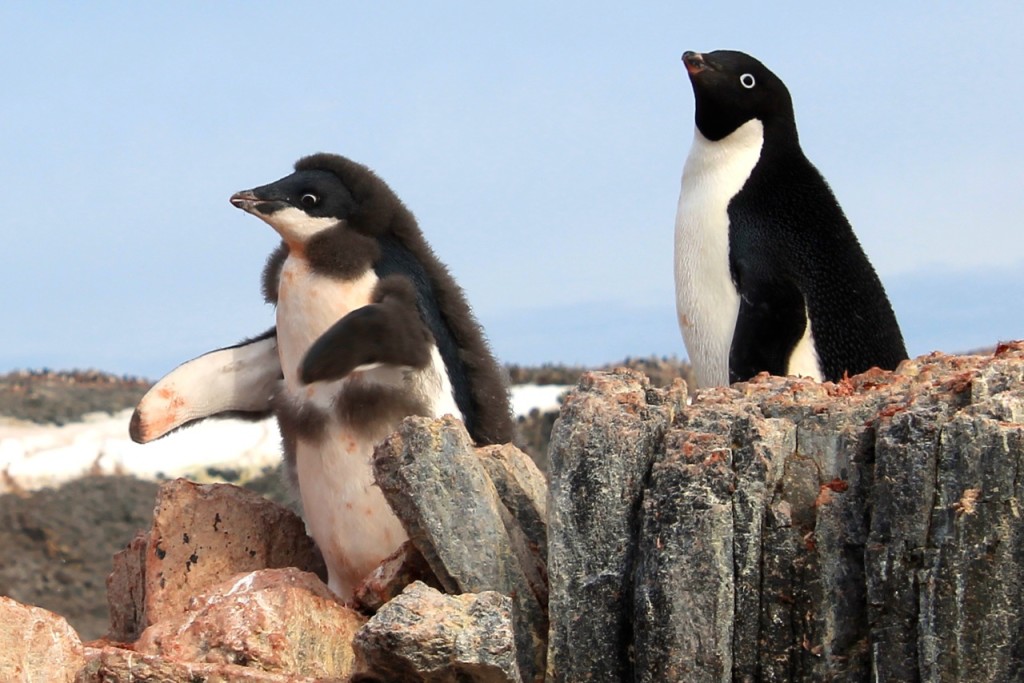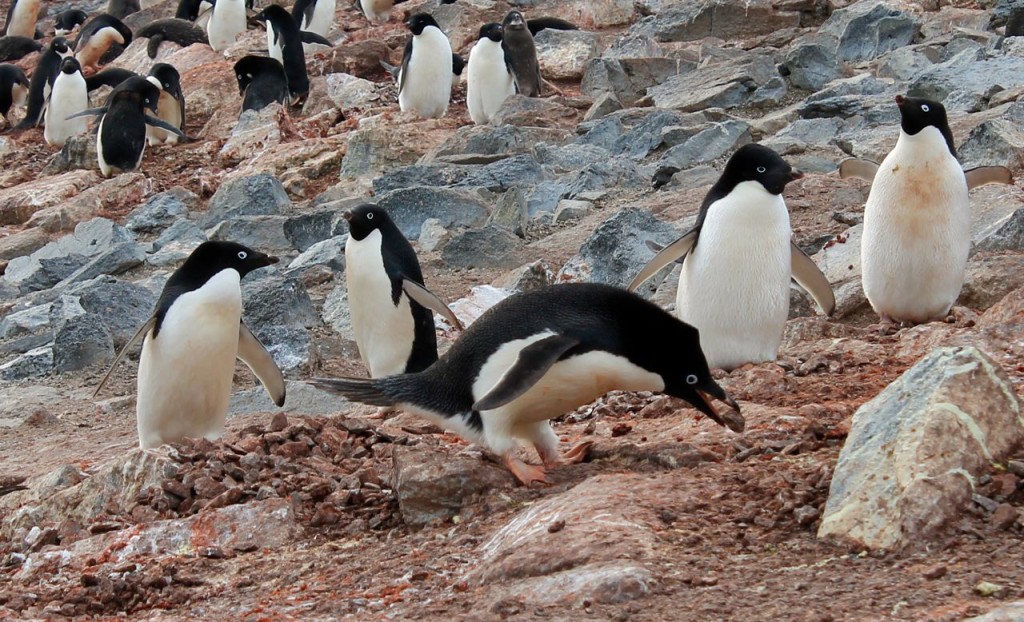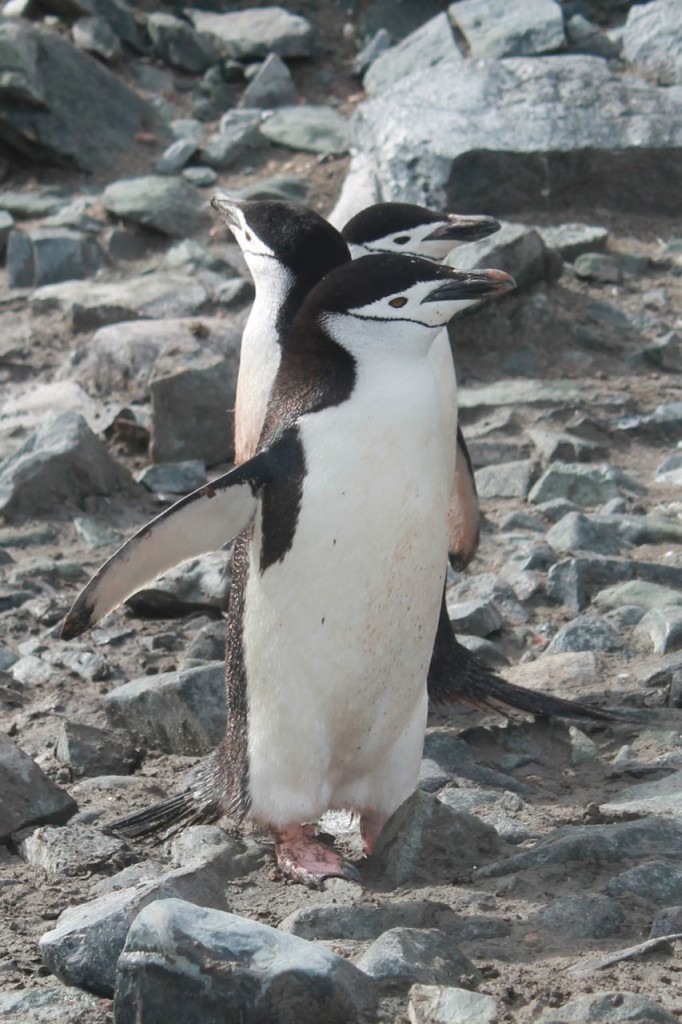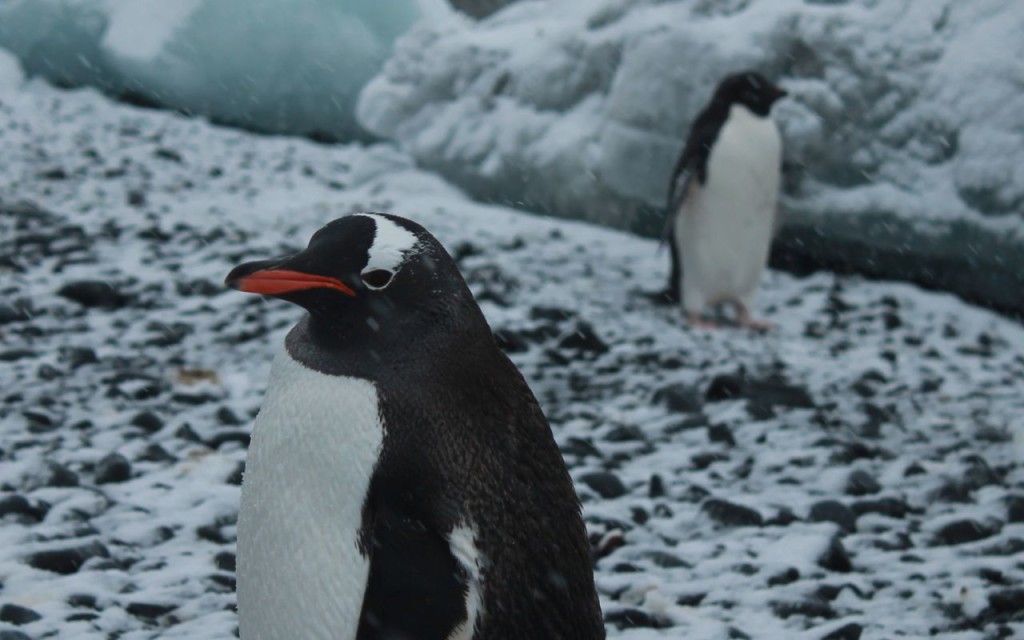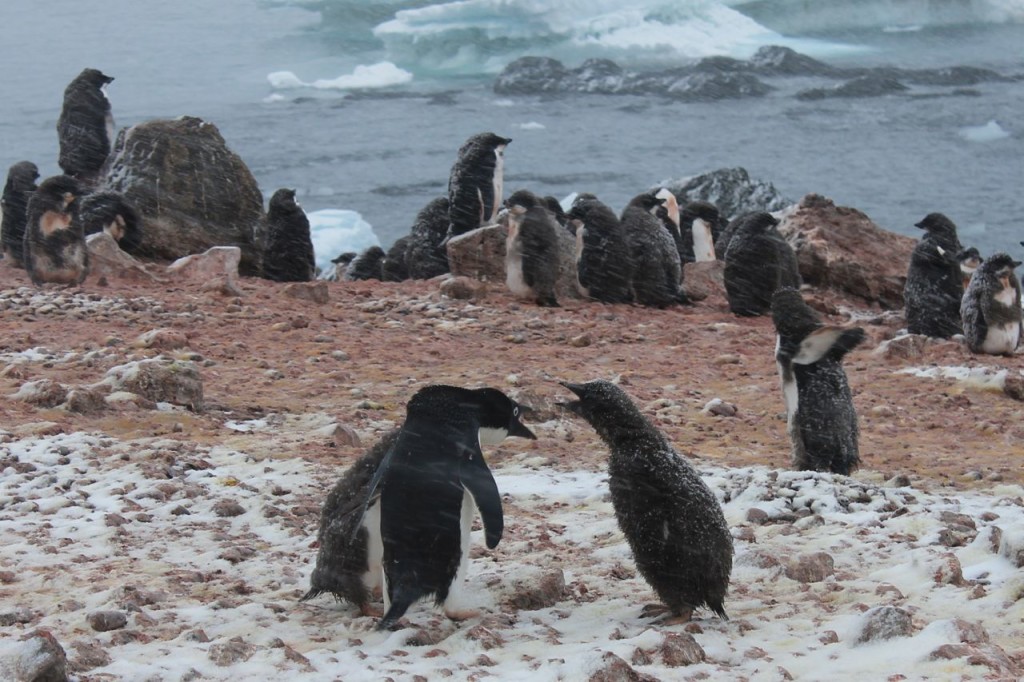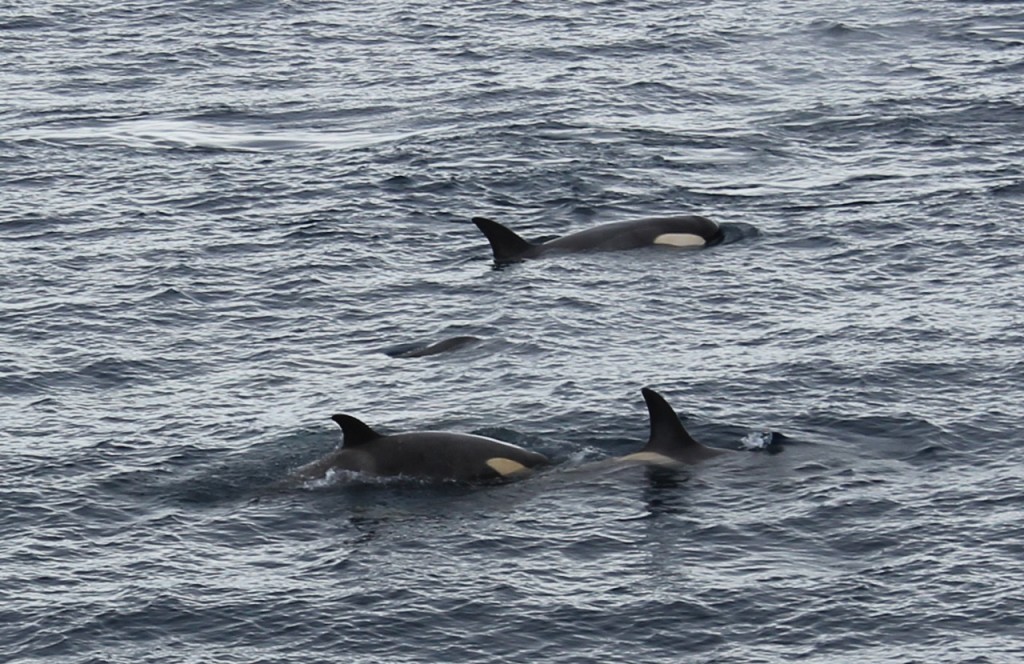The boat continued through the Bransfield Straight (the waters separating the South Shetland islands from the Antarctic peninsula) in the night. It was also colloquial known as the mini Drake. Only, if it was rough, I slept right through it. A couple of glasses of wine the night before a great aid to heavy sleep.
By breakfast we were moored at Goudin island. The first chance to walk on Antarctic land, an island just off the mainland of the peninsula. It was also the first chance to carry out operation disembark. Multiple layers of clothing: thick ski trousers, rubber boots, high coat, thermal coat, woolen hat, life jacket. Followed by a patient wait to board the small boats that took us out to shore.
On the approach through the crisp cold air, the island was striking not just for its novelty. The overwhelming smell of guano that burned the nostril on the approach. In other words, seabird shit. The island was home to thousands of penguins. Stretching out in polite squawking as far as I could see. Three species coexisting: Adelie, Gentoo, and Chinstrap. The immediate temptation was to take hundreds of photos, the affable and personable way these creatures waddled around impervious to the human presence. I did succumb to this at first. Yet eventually I stopped, and simply sat to watch them.
The Adelie penguins were in the greatest of numbers. In sight, they’re perhaps the least undistinguished of the penguin species. Smaller, white front, black back, black head. No interesting markings or splashes of colour. However, in pose, they’re perhaps the most entertaining. When walking, their head is arched downwards. Eyes often on the ground to pick a cautious and uncertain path over the rocks and snow. The appearance of disproportionately small legs adding to a look of instability in motion. On encountering the nearby presence of a human they will often stop, head craning to the left and the right. But if you stay quiet and nonthreatening they will ease and walk right on by.
It was late Antarctic summer, and the penguin chicks were almost fully grown. They grow incredibly fast. If we were to put this in human terms, they gorge from a 3kg baby to a fat lined 90kg adult in the space of just a few months. It’s needed. By Autumn they are on their own in the darkening Antarctic oceans. Until then, the parents feed them incessantly. Taking it in turns to hunt and eat krill or fish in the oceans, before returning to regurgitate it into the eager chicks mouth. It’s a close family unit. Mum, dad, and ordinarily just one chick. While the chicks are now quite large, many of them are still lacking their sleek water resistant lining. They require more feeding yet before they can take to the water. Half way through the malting process, they’re fluff balls on hind legs. The appearance that a drunk friend has gone erratic with a shaver.
Some chicks were practicing nest building. These islands are baron of all vegetation, and the rocks take on important meaning. Pebbles are used to build nests. And in courtship a male will demonstrate its fatherhood credentials by gifting these to a female. It’s therefore important to be able to pick your pebbles well. I saw one chick patiently looking for stones, picking them up with his beak, and placing them a few feet away. Practicing a ritual that could decide it’s dating credentials in seasons to come. Yet he seemed completely obliviously to the fact that another chick was then taking these stones when it’s back was turned, placing them in its own nest pile another few feet away. There’s no honour between men when it comes to chasing women – even for penguins.
While penguins spend most of their life at sea, they return to these same patches of land to breed and raise chicks each year. And in the summer time they co-inhabit in incredible numbers. They also live side by side by other penguins. In fact two further species existed on this island. Chinstrap penguins are a little larger than the Adelie penguins, and named based on the tell-tell markings across the chin. They’re often called cheeky chinstraps. Testament to a personality that is similar to the Adelie’s.
And then there are the Gentoos. They seemed much more self-assured. Larger, more upright posture, and a face that I felt was more suggestive of sinister plotting. Perhaps that was just my cultural background. Many others on the boat hadn’t a clue what I was talking about. For me it was the splash of orange on their break, just like the criminal mastermind of a penguin in Wallace and Gromit, that betrayed their inner character.
I watched Adelies further in the snow of Brown Bluff that afternoon. The snow gradually turned the beach white, and with a maze of small ice bergs out to shore, this felt like true Antarctica. It was our first landing on the peninsula. The continent proper. Pictures were snapped of many with seven fingers in the air – their first footstep on this most difficult to reach continents to be immortalised in photo albums.
Out to sea on some rocks I saw five shapes moving. Through the snow they appeared to be human figures. Active and close together. After a second I saw they were nothing of the sort. They were penguins from behind. Their black backs looking like silhouettes. I’m realising why penguins are so readily personified. On their feet and with flippers for arms. Their colouring is often depicted in cartoons as a tuxedo. They make for comical buffoons in the imagination. In reality, their dress is smart evolutionary camouflage for when they’re at their most graceful – in the water. When in the sea, their black backs help to camouflage them from above against the dark of the depths below. While their white front masks them from below against the lighter sky and sea ice. Here, in their element, they can stay under the water on one breath for minutes and have been known to dive to depths of 175m. And they’re not just powerful divers. They have endurance too. They may travel a 300km round trip for on feeding trips for their chicks. Just a little bit further than my local London Tesco metro! And these are just statistics for the Adelies. Larger penguin species can swim even deeper and further.
It was feeding time while we watched a rookery on the beach. Some of these chicks were younger and not yet moulting. Brown and totally covered in fluff, they looked like hedgehogs on their hind-legs. They stayed still in the cold, often huddled together. Wings were held tight to the body to converse body heat. Occasionally one chick would flap its wings energetically. I’m told this is to build muscle strength. Exercises before they take to the water for the first time. The chicks were in a crèche. Just a few adults to guard and keep them out of mischief while all the others hunted. These adults returned sporadically. Waddling up the beach with an intrinsic knowledge of where they’d left their chick. Only others were hungry too. Adults were mobbed. Three or four other chicks would descend in the hope of gaining food. The adults technique for warding them consisted off two stages. First, a threatening squawk at their cheek. Secondly, the adult would turn tail and scamper off at a run. It’s chick, after a moment of indecision would follow, only with it’s shorter body, it’s attempts to keep up were simply frantic. It was like a scene out of Benny Hill. This pursuit would continue until the adult had found some clear room. And often it would take two or three times of chasing until some truly clear space had been found, and they could feed in peace.
While penguins gain safety in numbers they’re not impervious to predators. On Goudin island I saw two birds, Brown Skewers, were playing tug of war with the body of a chick. And in Brown Bluff, a Leopard seal toyed with a penguin on the ice. After it mis-stepped, the seal pounced, pulling it into the water. It took minutes of thrashing until the ocean calmed. To belie their cute appearance, penguins are very tough skinned animals.
Further out in deeper waters penguins must also evade the orcas. More commonly known as killer whales (although they’re not strictly whales, but more closely related to dolphins!). Lunch time was interrupted by an announcement on the ships Tannoy system. “Orcas sighted from the bow of the ship”. But this was no reason for panic. Even if these creatures are incredibly smart hunters, they knwo better than to go for a 3,000 tonne ship. “If you would like to come out on deck you will get a great view of a pack of Orcas.” Almost everyone fast left before the final course arrived. Ice cream neglected to melt away. Jackets and hats found we crowded out on the front desk. These waters were sheltered, and the air calm and crisp, as we coasted towards the pack, a gleaming white glacier covered coastline as their backdrop. There were about 8 of them. When they rose above the surface their blowholes would expel a short, sharp, and loud jet of air and water. With keen eyesight this is how you spot orcas or whales from a distance – you look out for the spouts.
Orcas will often stay together in groups. For both social and hunting reasons. There is an amazing clip from the BBCs Frozen Planet that sees a lone seal in its last moments, all of course softly narrated by David Attenborough. The seal attempts to retain safety from give attacking seals on a floating block of ice. They’re unable to reach it directly, so instead they make waves. Literal waves. In complete unison they use their powerful tails to propel waves of water directly at the seal to knock it’s off the ice. Waves from one side and then to the next. It’s an attack strategy that Sir David tells us rarely fails. Once sufficiently toyed with and exhausted the seal is an easy picking. Game over.
